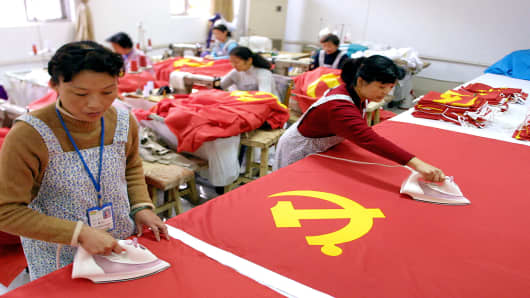If you are looking at China's monthly manufacturing data to gauge the strength of the recovery in the world's second largest economy there are three "key thresholds" you should monitor, says one economist.
China's official Purchasing Manager's Index (PMI), released on Monday, rose to 50.9 in March, underperforming expectations for a rise to 52. The index rose to 50.1 percent in February. HSBC's China PMI rose to 51.6, largely in line with a flash reading of 51.7 and up from 50.4 in the previous month. A reading above 50 indicates expanding activity and one below 50 signals contraction.
According to Xianfang Ren, senior economist at financial analysis firm IHS, a good way to look at the data is via key thresholds.
(Read More: China Factory Profits Up 17% as Recovery Picks Up)
She tells CNBC that a reading between 50 and 51 points to a "weak rebound" in the broader economy, while between 51 and 53 indicates a "moderate-to-slightly stronger rebound." Any reading above 53 signals a "very strong rebound." She added that the index is unlikely to go beyond 53 this year.
The latest official PMI, which is compiled by the government, indicates the rebound has started but is not a very strong one, said Ren. "The PMI is on the borderline of 50—it's not quite strong. This is not a cheerful number for us to celebrate."
March is typically a stronger month for manufacturing activity as it becomes warmer and also because it comes after the Lunar New Year holidays - a two-week period during which many businesses stay shut. In 2012, the official PMI jumped to 53.1 in March from 51 in February.
(Read More: China's Urbanization Leaves Migrant Workers in the Cold)
"The pace of improvement in manufacturing activity is disappointing. From 2005-2012, on average, the PMI rises 3 points in March from February," said Tommy Xie, economist, Treasury research & strategy at OCBC Bank.
While new export orders rose in March, Xie notes the outlook for the manufacturing sector remains uncertain due to fragility in external demand, given weakness in key export destination Europe. The new export orders index climbed to 50.9 last month from 47.3
In addition, he said improvement in new domestic orders, which rose to 52.3 in March, will hinge on continued strength in property construction, which may come under pressure due to recent cooling measures.
"Property investment may slow because of fresh round of tightening measures, same with infrastructure investment—the government has said it doesn't want infrastructure to grow too fast—they want to control pace of growth," he said.
(Read More: China Still the World's Best Real Estate Market: Pro)
Over the weekend, Beijing and Shanghai vowed to enforce property cooling measures outlined by the central government earlier in March, including a 20 percent capital gains tax and higher down payments for second-home buyers.
"Looking forward we are still facing uncertainty—those drivers that have supported the manufacturing sector are facing uncertainty," Xie said.



